URBAN APERTURE(S) >< POROSITY AS A NEW MODEL FOR HYBRID PUBLIC SPACE
This paper was included into the book “URBAN HYBRIDIZATION in Contemporary Territories”.
Here you can read the english version and you can find the spanish version here.
Submmited by: Francesco Cingolani, Domenico Di Siena, Manu Fernández, Paco González, César Reyes Nájera and Ethel Baraona Pohl.
URBAN APERTURE | POROSITY AS A NEW MODEL FOR HYBRID PUBLIC SPACES
Topics
# Urban Pore/porosity
# Hybrid typologies of public urban spaces
# Hybridization design strategies and case-study in urban, landscape or architectural design
Abstract
In the past 20 years, the communications revolution produced by the Internet substantially affected the way we interact with the world. This has driven us to a change of perception in the traditionally recognized opposition between real and virtual. Nowadays, a new paradigm is actually re-drawing reality as a complex system of relations between layers as “face” (physical) and virtual. Architects and urban planners can no longer ignore this new reality generated by ubiquitous computer technologies that we have translated to the reconfiguration of physical space in urban areas, with the term “hybrid public spaces”.
This “hybridization” of space is only an expression of wider radical changes between analytical systems (order and spacing) to synthetic (complexity, connectivity, permeability) ones. In a system characterized by its high capacity for communication, if space becomes a mix between reality and virtual presence, the separation between private and public space becomes obsolete. According to this theory of urban permeability, the concept of “filter” is important as a new indispensable (Technological? Architectural? Social? Cultural? ) device. Filter as a mean of connection with the capacity of handling private/public, real/virtual, inside a system where the channels are not separated anymore. Now these channels are communicating -APERTURE-.
In this model, public space is defined as the space in which information can flow freely. The public information consists in the communication generated from private channels screened by urban filters. In our point of view, this filter function cannot be automated: only people, through his sensitivity and emotions, can solve this function of discernment.
We propose an anthropocentric definition of these «hybrid public space»: considering the technological importance of information channels but restoring spirituality and intelligence that can only be provided by humans beings.
1. CURRENT MODEL: HYBRID SPACE’S THEORY
As commented by Daniel Innerarity in 2006, talking about the city: homogeneous and stable space is now an extreme case within a global area of local manifolds connected. Rather than neighborhoods, local networks are developed and public debate is conducted in a virtual space, where streets and squares are no longer the primary venue and staging.
Internet seems to offer an alternative “place” to the “traditional” sites for social relationships. This fact can be understood as a problem that can increase the subsequent depletion of public space, or conversely, may be regarded as an extraordinary opportunity to strength local social relationships, creating the necessary budgets to improve the vitality of the public spaces. Internet is now the “place” where the most successful models of collective management are being tested.
According to Juan Freire, the crisis of urban public spaces (physical) is also due to the lack of (open) design that generate into citizens a genuine interest to use it. Freire has successfully introduced into the discussion concepts like “hybrid spaces” to refer to the opportunities offered by the hybridization of the physical and digital in public spaces.
Social Networks: Communities 3.0
When Internet access became popular, in the late nineties, many fans spent hours chatting with anyone, in open chat rooms. Today, in social networks the behaviour is different. In these networks we’re not interested in talk just with someone else, rather than that, we want to meet people with whom we share a certain passion. A social network consists of two things, first a window (a personal description) and secondly, a system to establish contact (friendship) with other users (that’s communication).
The space has been transformed into a network, a permanent flow. When these relationships used to happen in a presential space, in most of the cases it was a public space. This was the space in which everyone was able to show himself and where he could meet and communicate with other people. This public open window is probably not enough anymore for one reason: it’s too generic. Now…prior to “spend” time in getting to know someone deeply, you want to know more, or have some more safeguards, such as the fact that he or she is friend of your friends, or likely that both of you have similar ideas and tastes, like attending the same entertainment venues.
The importance of Self-organization
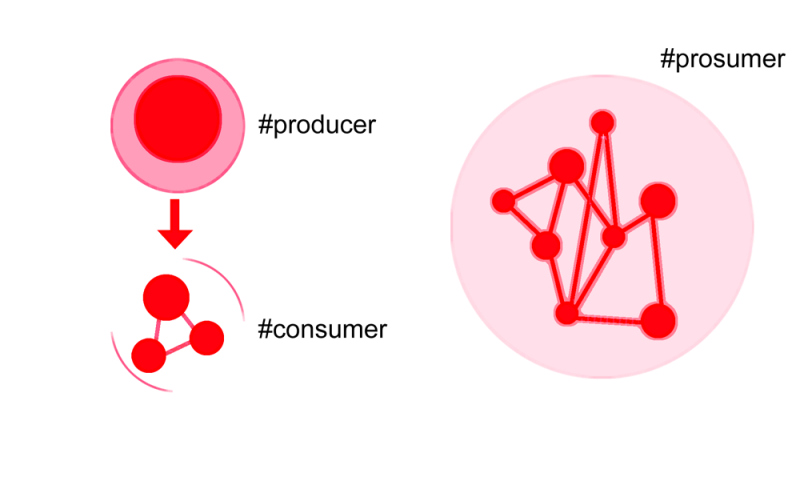
Self-organization & “prosumer”
New communication technologies enable new ways of collaboration and organization oriented to the management of common property (public spaces). From one side, there are emerging self-organizing phenomena as described by Kevin Kelly in “Out of Control”Smart Mobs” (2002), while, in the other hand, methods and collaborative Open Source movements are constantly developing, improving and spreading. The self-organizing capabilities of informed societies, capable of reinvent their structures, are being discovered, and the way they use the phenomenon of virtual mirror allowing the interaction between information about an specific situation with individual decisions.
Digital citizen participation, supported by computer tools, is not based on a model that express the plurality and organization of constituted communities. This is a non-collective way of participation since the dynamic comes from individual action and interaction. (1994) and by Howard Rheingold in ”
Decentralization
The networks boost a new type of control: decentralized control operated by a plurality of independent individuals who collaborate using distributed mobile computing and communication capabilities. The Information and Communication Technologies (ICTs) do not represent the solution, but an opportunity to improve our ability to manage the territory. They can be used for completely different and contradictory purposes. On one side you can take advantage of its enormous data processing capacity to centralize all information and try to “solve” the urban complexity, but they can also be used to open and decentralized decision making.
It is about explore how ICTs can define an urban management structure where discontinuous control poles can coexist between an environment of self-determination (ownership) and freedom. This is a close idea to Buckminster Fuller’s definition of tensegrity: “The integrity of the whole structure is invested in the finitely closed, tensional-embracement network, and the compressions are local islands“.
The presence of a centralized entity is not required when the control devices and return of information (feedback) allows the actors to see or realize the consequences of their actions. The phenomenon of unconscious self-organization becomes conscious and intentional control when it allows individuals to understand the effects of their actions. Here we can talk about the concept of tensegrity, when referring to a management model where decentralized decisions join centralized ones preventing a fully closed and omnipresent “dynamic of control” .
Reversing the supremacy of centralization on individual decisions, citizens can become aware of their actions and coordinate them intentionally. This process can get back the necessary legitimacy and credibility to interventions in degraded urban areas.
Open Source City
The Open Source (OS) development model presents quite interesting features that could be applied in urban management processes. Very interesting is the concept of “integrator”, which coordinates new software’s versions, approving or rejecting the integration of new pieces in the code: a coordination position without the possibility of liability of any kind. This model has three different advantages when it is adopted for the development of an urban project:
1) Avoid arbitrary exclusions. The project accurately reflects the needs and uses.
2) Rapid and evolutionary benefits from the dynamism of your community.
3) Durability, once the project is relevant, its developments and adjustments are secure.
The Open Source philosophy shares with cities the economic principles of urban agglomeration and networking. Just like the OS that appears where the common benefit is bigger than the sum of private interests; cities appear when their infrastructure and facilities benefit the community in such way, that justify high expenditures. At the same time it has been observed that the development of urban areas are largely the result of spontaneous actions and communitarian dynamism, while no institution is able to centralize the decisions. These dynamics allow the possibility of freeing the distribution of services and public goods (at least in part) of some political decisions, that end up damaging some urban areas with its low coherence and slowness.
2. SOME EXAMPLES ABOUT HYBRID SPACE’S MODELS
Oportunities
Internet offers two interesting things: horizontal communication and transparency. Both characteristics differs from what our contemporary society is used to. Transparent communication means that everyone can communicate with everyone, there is no hierarchy and information travels with the same rights in all directions.
Many projects have proved nowadays that Internet is capable of contacting people from the same neighborhood and then organize physical events, due to the fact of living nearby. This means that Internet is able to create synergies between physical and virtual networks.
The proposals listed below, research such synergies:
Critical City – www.criticalcity.org
Augusto Pirovano, Matteo Battaglia, Davide Portanome, Matteo Uguzzoni, Duccio Machnitz / Italy
This is a local social network for recreational urban re-qualification. Users of this network can propose urban actions, meet their neighbors and improve living environment in enhancing the networking between residents of the neighborhood. Under the circumstance of games and challenges offered by its users, it can be developed different actions in the physical public space, connecting in an interesting way the virtual with the physical environment.
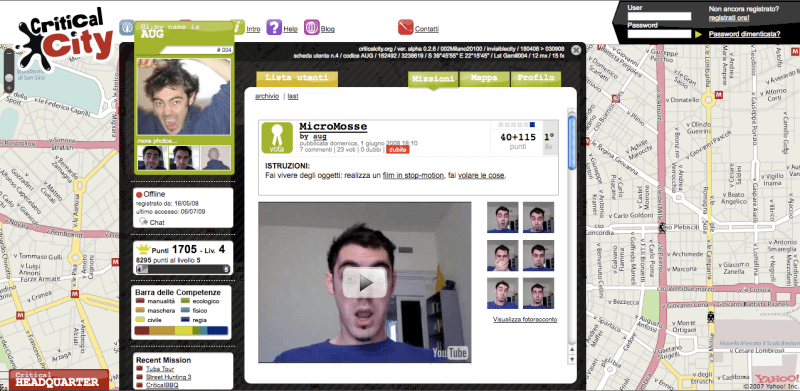
Critical City
S.O.S – www.eseoese.info
Platoniq (www.platoniq.net) / Spain
SOS is a virtual device to post messages (offers, requests and alerts to citizens) in public spaces and events. It’s inspired by the traditional English Speaker’s Corner and is linked to other Platoniq’s projects, as Burn Station and the Bank of Common Knowledge.
Its scoop is to link people from the same area with common interests that wants to share information and resources. With the SOS application, interested people can record advertisements that are searchable on the Internet, according to topics and keywords. When it finds connections between specific responses to messages or advertisements, an SMS is automatically sent to the interested persons to fix a possible meeting.
SOS is aimed to small communities of users sharing a problem, which are close geographically, but doesn’t known each other, or users that are seeking to exchange something. This new paradigm can also be applied in organizations that were born from networking and ICTs. Using creative dynamics, they seek to solve problem through cooperation and self-organization of equals.
MEIPI, Colaborative Spaces – www.meipi.org
Alfonso Sánchez Uzábal, Domenico Di Siena, Francesco Cingolani, Guille Álavero Rey, Jorge Álavero Rey, Pablo Rey
Meipi proposes an innovative model of georeferenced content management through the creation of collaborative spaces called “geoblog” or “wikimap”. This is a way to publish information which is part of a georeferenced collective publication, in the same way as the blog is a way of individual posting on the Internet.
Also, Meipi can be the start point of local media and hyper-local social networks, where virtual relationships can become “real” contacts or events in the nearest public space. It can reinforce local networks through new types of social media (news media which are produced by a particular community) that can be defined as “local social media”, where the community producing the news is made up of people from the same local environment, ie. the same neighborhood.
NeighbourTXT
Chris Vanstone, Mickaël Charbonnel / UK (www.fusedspace.org)
With new technologies there are new opportunities to create virtual public spaces, capable of developing new interactions in a local context. Communication between neighbors is the first step for increasing social capital and also improve the quality of life in a neighborhood.
NeighbourTXT assigns a phone number to each district – allowing fragmented communities to communicate and interact. It aims to help residents improve their quality of life through increased social capital.
Screen
Neil Matthew / UK – Oyvind Billington Larsen / Norway (www.fusedspace.org)
‘screen’ connects people, places and time zones, while proposing an exchange of perceptions between people from different cultures. Using a positive approach to the concept of monitoring, it allows the virtual space’s characteristics to reach the public space.
‘screen’ permits people to see how other culture acts, select a square from another country and see by themselves what happens there, instead of having the media as intermediaries.
People often have a negative reaction to these technologies. This project takes the idea and technology of CCTV surveillance and uses it in a positive way, not only to expand the potential of public space and make connections between spaces and people, but also to help people to accept the reality of a future in which surveillance in public space will be a commonplace.
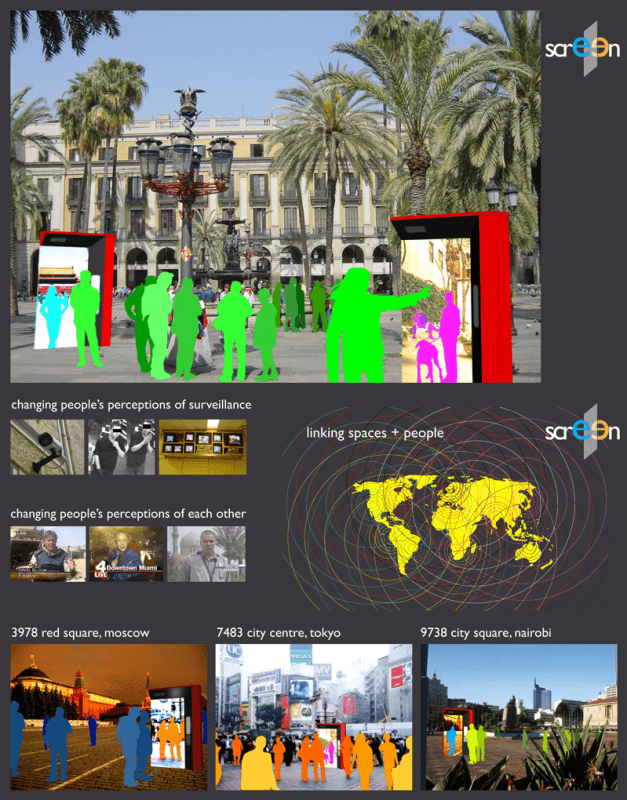
Screen
Bus Browser
Chris Vanstone, Jennie Winhall / UK (www.fusedspace.org)
Bus Browser proposes to redesign public buses as vehicles for the community, beginning with the replacement of mass media advertising used to “invade” the buses with an information system generated by the local community.
Bus Browser adds value to the virtual information, giving it a physical context. Passengers face opportunities in real time, while going through real places.
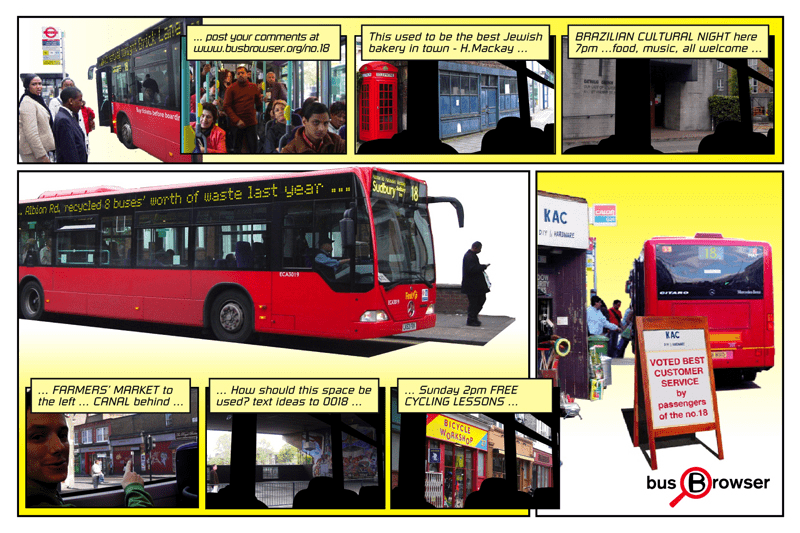
Bus Browser
A google architecture
Andreas Ferm + Jani Kristoffersen / Jani Kristoffersen + Andreas Ferm / Sweden (www.fusedspace.org)
This project creates a scenario for a not so distant future. This is a reflection about architecture, politics and the possibilities offered by new technologies. It presents new ways to associate virtual information to physical spaces that are now almost a reality: Augmented Reality. Who will control the city average?
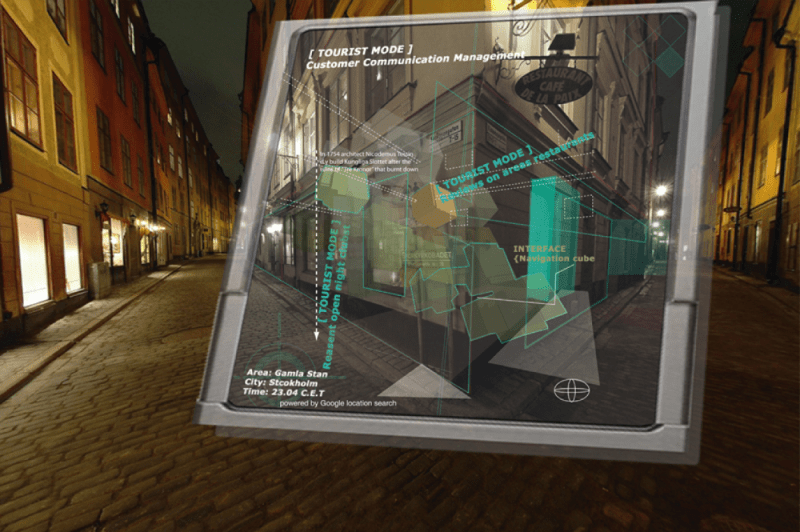
A google architecture
Interactive city.film.museum (www.fusedspace.org)
Beatrix Vogler / Austria
Each city has its cinematic history that allows us to reconstruct the different roles that has played through history. City.film.museum gives us ideas on what the city has been, what the city is this and what could be a possible future through a projection of desires, hopes and fears.
The interaction between the film and the real city allows to explore the city in new ways.
The structure is an hybrid which stands in the urban space, enriching it through the addition of a new perception layer.
Artificial Sky
David Ruy, Karel / USA (www.fusedspace.org)
This is a proposal for an artificial sky in Central Park, New York. Exploring new possibilities for interlinking natural and artificial systems, it merges the virtual and real using high technological conditions.
A light structure formed by a cable network is deployed to become an ephemeral infrastructure. This cable network will operate as a “sponge” that absorbs and reflects the natural and artificial means. With this Artificial Sky, it will be induced climate zones (fogging systems, heat lamps, etc.) with lighting effects and also areas with environmental sounds.
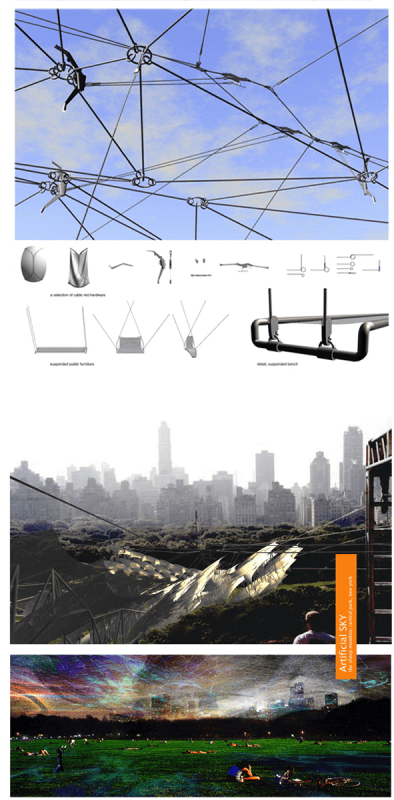
Artificial Sky
3. HOW TO IMPROVE THE HYBRID SPACE MODEL: permeability as an urban anthropocentric model > URBAN APERTURE(S) >
Paradigm shift
The examples of hybrid spaces we have mentioned above show a breakdown in traditional conception that used to establish an opposition between between real and virtual space.
This hybridisation of space is actually an expression of a radical and comprehensive change, that moves us from an analytical system (order and separation) to a synthetic (complexity, connectivity, permeability). Thus, there is a perceptual transference of reality, reflected in the step from a bipolar structure of opposition (material / immaterial) to a multilayer structure and interconnections, in which the physical represents only one of these layers.
Accepting the existence of intangible factors in the world’s settings is obviously not something new. What changes now is the perception of such intangibles as structuring the world and our daily life, besides being fundamental for their interaction. It could be say that technology is reducing the gap between the material and spiritual.
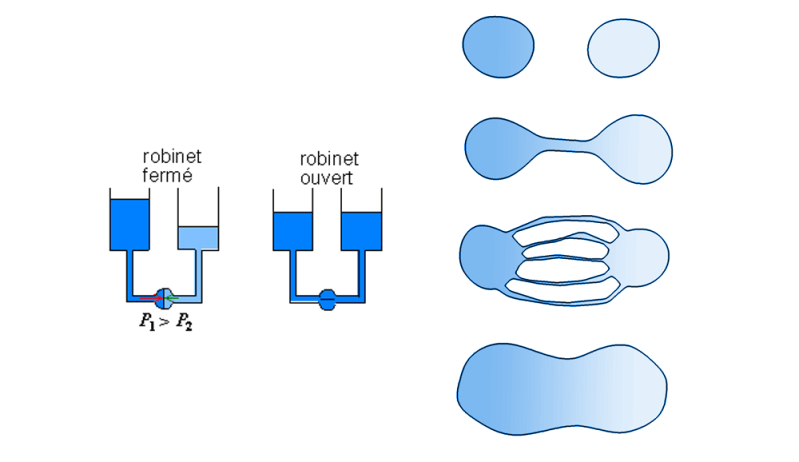
Communicating vessels: André Breton used this physical process as a metaphor for the restoration of unity between the world of wakefulness and sleep
In a system characterized by its high capacity of communication, micro-communications are multiplied and with them, the contents that produce reality. Much of the impressions that are traditionally considered as part of the private sphere, are now transformed into media content, traveling through different technologies, each one with differents level of privacy (or publicity). This variable privacy level makes obsolete the traditional gap between private and public.
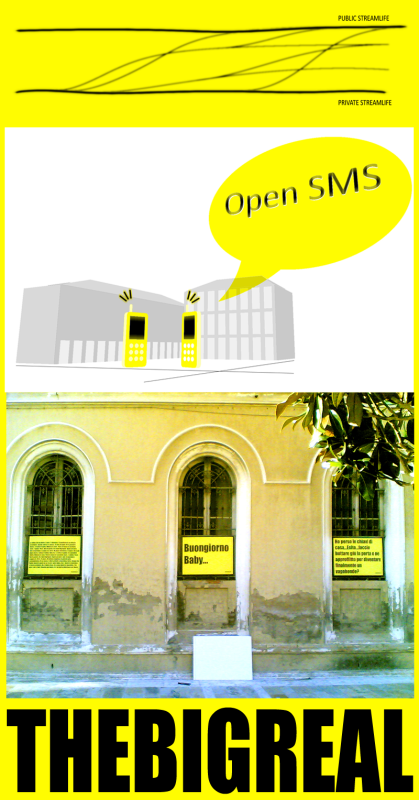
THE BIG REAL: Exhibition of private SMS in public spaces – CREDITS: Manuele Baldoni, Francesco Cingolani (Algomas Arte RIVOLUZIONARIO)
From an architectural point of view, the space is reconfigured as a diffuse and decentralized structure. The nodal model of public space (the square) is evolving towards a model of micro public spaces with a completely new horizontal and hyperlocal nature.
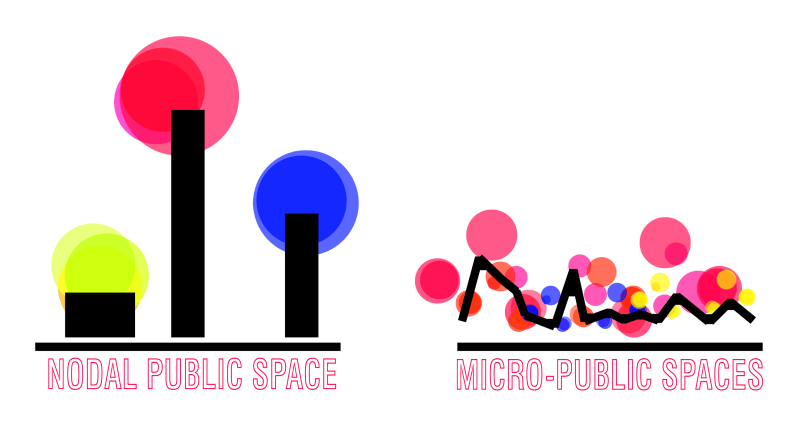
Proposal: Space + relationships = URBAN APERTURE(S)
These considerations impose a revision on the definition of “public space”, understood untill now as the place where anyone is free to move. This definition has been established based on a purely physical interpretation of the space, in fact focused on the right of the body (physical) to move freely. In our model, public space is defined as the place where information reaches its lower levels of privacy and runs transparently. From the standpoint of sociology, this definition implies a relational vision of public space, where communication is free.
That’s why we called our model URBAN APERTURE(S), focusing our research towards porous urban settings (filters), which replaces the analytical model of separations (walls).
The word APERTURE means “small opening” while at the same time it refers to a device that controls amount of light admitted through cameras. We believe that urban and architectural research should move towards this model of openness, and try to configure the spaces following these assumptions of permeability, transparency and mixed nature.
APERTURE(S) would be therefore a new device – Technological? Architectural? Social? Cultural? – able to make connections between private and public, physical and virtual, in a system where these media are not presented separately but communicating.
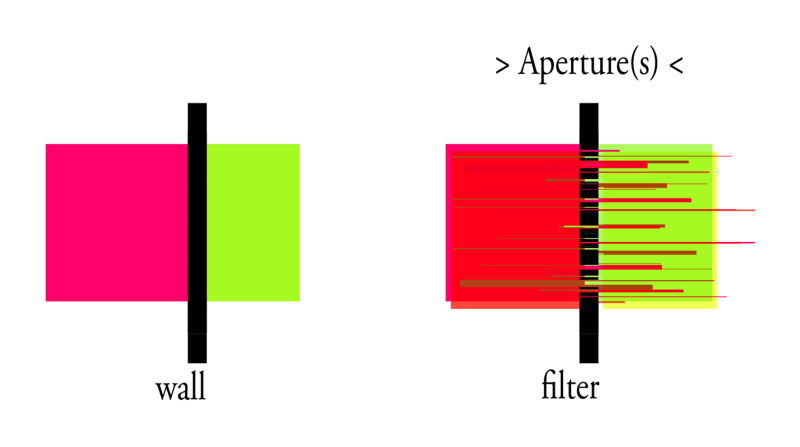
APERTURE(S) concept visualisation
These changes, despite being inspired by new technologies, are presented as an opportunity to change the current material and the technocentric system, toward a new order that restores spirituality and intelligence that can only be provided by humans beings.
This anthropocentric view, spatially founded in a relational interpretation of architecture and space, is also presented in a historical moment in which the former organisational structure, based on the consumption of objects, tragically shows its economic and environmental limits.
